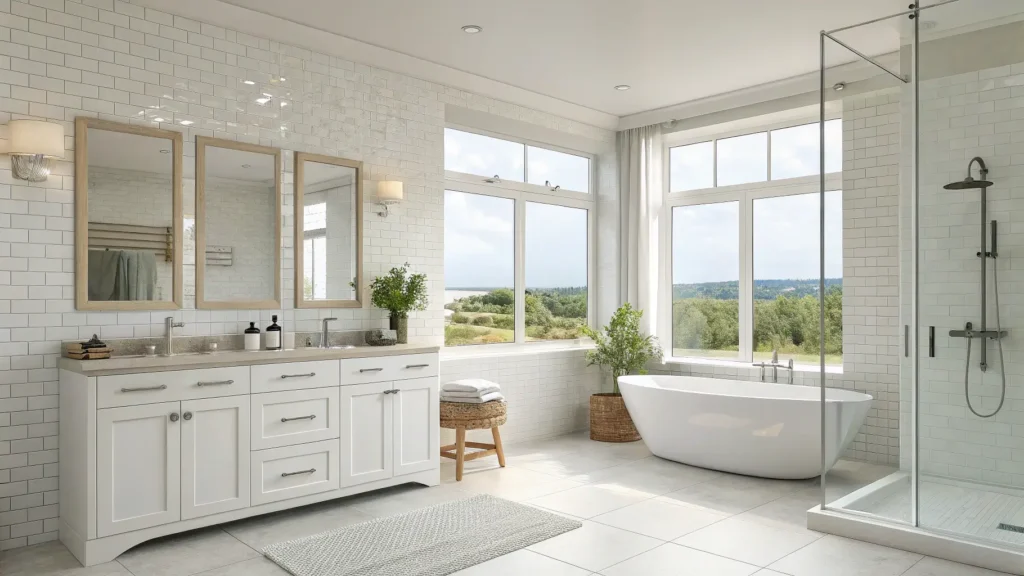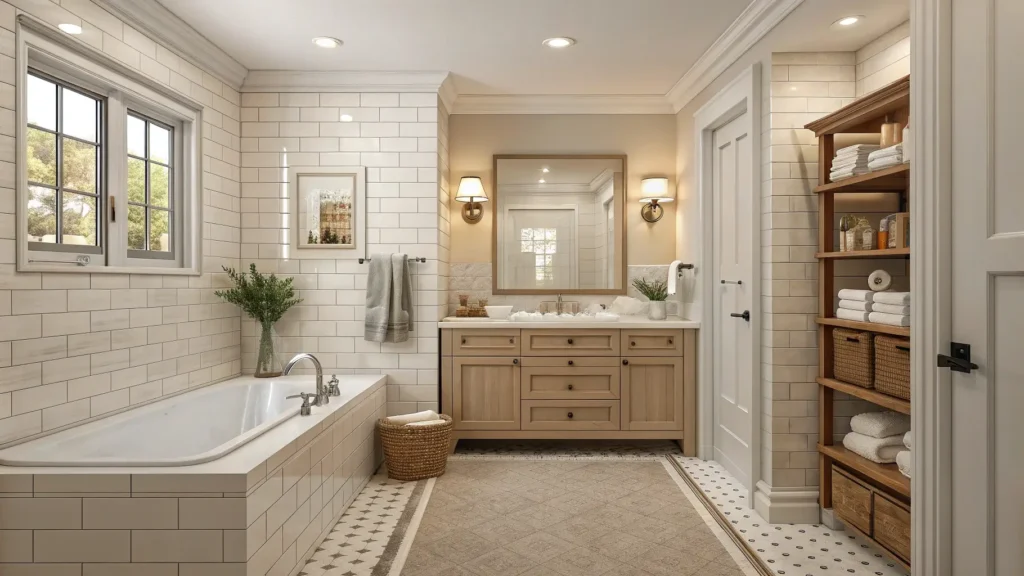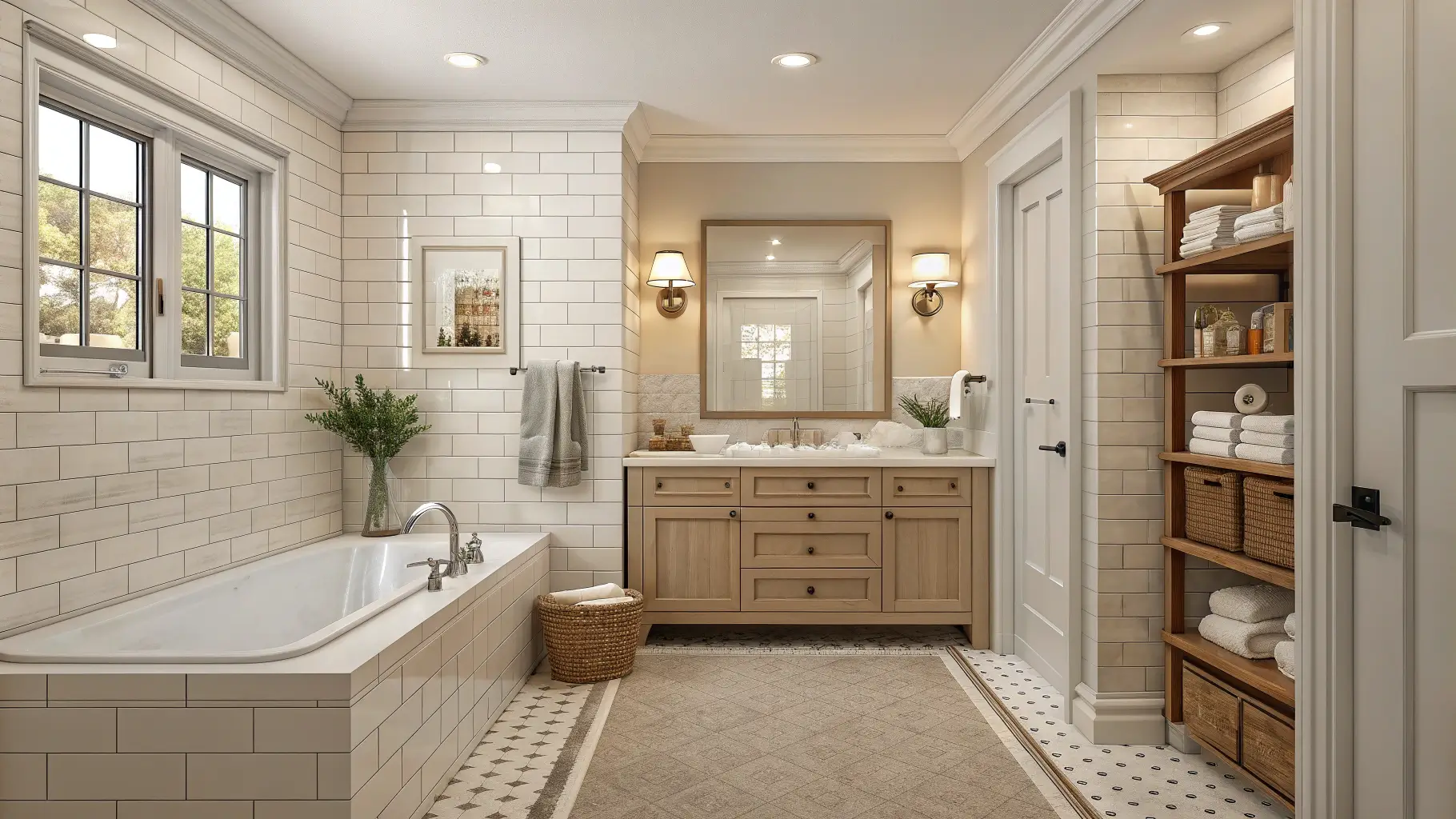Embarking on a bathroom remodel can be an exhilarating journey, promising a sanctuary of comfort and style. Yet, for many homeowners, this dream often veers into a stressful, budget-busting nightmare. In fact, studies show that nearly 60% of home renovation projects exceed their initial budget, with bathroom remodels being a primary culprit. The good news? Most of these costly and frustrating bathroom remodel mistakes are entirely avoidable.
This ultimate guide is designed to empower you with the knowledge to navigate your renovation with confidence. We’ll meticulously break down 20 critical bathroom remodel mistakes that homeowners frequently make, providing you with actionable strategies, expert insights, and practical tools. Our goal is to ensure your project is not just completed, but executed flawlessly, delivering a future-proof space that maximizes savings and minimizes stress. Prepare to transform your bathroom without the regrets.
TABLE OF CONTENTS
Planning & Budgeting Blunders (The Foundation of Failure)
A successful bathroom renovation begins long before the first tile is laid. The most insidious bathroom remodel mistakes often originate in the planning and budgeting phases, setting a project up for delays and spiraling costs. Overlooking these initial steps can lead to a cascade of problems down the line.
Underestimating Overall Costs & Hidden Expenses
Many homeowners focus solely on visible costs, completely overlooking the multitude of hidden expenses that can quickly inflate a budget. This is one of the most common and impactful bathroom remodel mistakes.
Initial budget estimates rarely align with actual project costs if not meticulously planned. A critical oversight is neglecting a contingency fund, a non-negotiable 10-20% buffer for unforeseen issues. Common hidden costs include demolition and debris removal, unexpected plumbing or electrical upgrades to bring systems up to code, material overages, and essential permit fees.
Our Unique Angle: To help you plan effectively, we recommend utilizing a comprehensive budget checklist. This tool helps account for every potential expense, from fixtures and finishes to labor and unexpected repairs.
Neglecting a Detailed Scope of Work & Realistic Timeline
Without a clear, written project plan, your remodel is essentially sailing without a map. This absence of detail is a recipe for misunderstandings and delays, making it a significant bathroom remodel mistake.
A detailed scope of work should break down the remodel into distinct phases: design finalization, demolition, rough-ins (plumbing, electrical), installation of major fixtures, tiling, painting, and final finishes. Establishing realistic timelines for each stage is crucial. Remember that potential delays due to material availability, contractor scheduling, or inspection failures can significantly impact your project’s completion. Clear communication with your contractor based on this scope is paramount.
Our Unique Angle: Visualizing the project timeline can prevent many headaches. Consider a sample project timeline template that clearly outlines key milestones, dependencies, and expected durations.
Ignoring Future Needs & Accessibility Considerations
Many homeowners design for the present, failing to anticipate how their needs might evolve. This oversight can lead to a bathroom that quickly becomes outdated or impractical, proving to be a short-sighted bathroom remodel mistake.
Planning for aging-in-place, for example, means considering features like grab bar blocking behind walls, wider doorways, or curbless showers. Similarly, account for family growth or changes in mobility. Integrating universal design principles from the outset ensures the bathroom remains functional for everyone. Additionally, roughing in for future smart home technologies (like in-wall wiring for smart mirrors or voice control) can future-proof your space.
Our Unique Angle: “Designing for tomorrow prevents costly redesigns today,” advises Sarah Jenkins, a certified aging-in-place specialist. “Simple considerations like reinforcing walls for future grab bars or installing an adjustable-height showerhead are small changes now that offer immense long-term value.”
Design & Layout Disasters (Functionality Meets Aesthetics)
A bathroom must be both beautiful and highly functional. Design and layout bathroom remodel mistakes can severely compromise daily use, turning an aesthetic triumph into a practical failure.
Poor Fixture Placement & Suboptimal Space Utilization
Even a stunning bathroom can feel cramped and awkward if fixtures aren’t strategically placed. This is a common functional bathroom remodel mistake.
Always adhere to minimum clearance requirements for toilets, sinks, and showers to ensure comfort and compliance. Consider how doors swing and optimize traffic patterns within the room. For small bathrooms, creative solutions like corner sinks, wall-mounted toilets, or pocket doors can maximize usable space. Ensure your vanity size and placement allow for comfortable access and sufficient counter space.
Our Unique Angle: Seeing is believing. Simple “before and after” floor plans can visually demonstrate the impact of good versus bad layout choices, particularly for common bathroom sizes like a 5×8 or a powder room. These visuals can help you avoid fundamental design flaws. What’s the Rule of Thumb for Your Bathroom Remodel Budget?
Insufficient or Poorly Planned Lighting
Lighting is often an afterthought in bathroom design, yet it profoundly impacts both aesthetics and practicality. Overlooking its importance is a glaring bathroom remodel mistake.
Effective bathroom lighting utilizes layers: ambient (general illumination), task (vanity, shower), and accent (for architectural features). Selecting appropriate color temperatures is key – generally, cooler tones are better for task lighting, while warmer tones create a more relaxing ambiance. Dimmer switches offer versatility. Maximize natural light where possible and pay special attention to specific lighting needs around vanity mirrors (side-mounted fixtures are best) and within shower areas (recessed, wet-rated lights).
Our Unique Angle: “A well-lit bathroom isn’t just bright; it’s smart,” explains interior designer Emily Carter. “Think about how you use the space: bright for grooming, soft for relaxation. Dimmer switches and varied light sources are your best friends for setting the right mood for any task.”

Ignoring Proper Ventilation (The Silent Killer of Bathrooms)
One of the most insidious bathroom remodel mistakes is inadequate ventilation, which can lead to serious health issues and structural damage that often goes unnoticed until it’s too late.
Exhaust fans are non-negotiable for removing moisture and odors. It’s crucial to select a fan with the correct CFM (Cubic Feet per Minute) rating for your bathroom size; a general rule is 1 CFM per square foot of bathroom area, with a minimum of 50 CFM. Proper ducting to the exterior, not just into an attic, is vital. Effective ventilation controls humidity, preventing the growth of mold and mildew, which can cause respiratory problems and costly structural damage to drywall, paint, and wood framing.
Our Unique Angle: Understanding the science helps. High humidity allows mold spores to thrive, leading to health risks and structural rot. To calculate your bathroom’s CFM needs, simply multiply its length, width, and height to get cubic feet, then divide by 7.5 (for 8 air changes per hour, recommended).
Choosing Trendy Over Timeless Materials & Styles
While appealing in the short term, chasing fleeting design trends can quickly make your bathroom feel dated, impacting your long-term satisfaction and resale value. This is a common aesthetic bathroom remodel mistake.
Consider the longevity of your choices versus the rapid pace of design trends. While personal style is important, balancing it with classic, enduring design elements can significantly impact resale value. Think subway tile, neutral color palettes, shaker-style cabinets, and quality, simple fixtures. These elements offer a timeless appeal that won’t require a costly re-do in a few years.
Our Unique Angle:

This visual gallery highlights materials like classic ceramic tiles, natural stone, and polished chrome fixtures that stand the test of time, ensuring enduring appeal and value.
Structural & Functional Faults (The Hidden & Costly Mistakes)
Some bathroom remodel mistakes aren’t immediately visible but can lead to major, expensive problems down the line. These structural and functional oversights require meticulous attention during the renovation process.
Skimping on Waterproofing & Moisture Barriers
Water is the bathroom’s greatest enemy, and inadequate waterproofing is arguably the most disastrous bathroom remodel mistake a homeowner can make, leading to severe structural damage and mold.
Comprehensive waterproofing systems are non-negotiable, especially in wet areas like showers (shower pans, wall membranes) and around tubs. Different types of waterproofing materials, such as liquid membranes, sheet membranes, and cement board, must be correctly installed. The severe consequences of water damage include wood rot, extensive mold growth, compromised structural integrity, and pest infestations. Ensure all seams, corners, and penetrations (like shower valves) are properly sealed.
Our Unique Angle: To ensure your contractor follows best practices, use a waterproofing checklist. This helps you review critical steps like proper sloped shower pan installation, overlapping membrane application, and flood testing.
Overlooking Plumbing & Electrical System Upgrades
Ignoring outdated or insufficient plumbing and electrical systems during a remodel is a dangerous and costly bathroom remodel mistake. These hidden issues can lead to safety hazards and functional problems.
Inspect for outdated piping materials like galvanized steel or polybutylene, which are prone to corrosion, leaks, or failure, requiring replacement. Ensure your electrical circuits can handle modern bathroom appliances and lighting. GFCI (Ground Fault Circuit Interrupter) outlets are mandatory near water sources for safety. Proper venting for all plumbing fixtures is crucial to prevent drain issues and sewer gas odors. Additionally, assess and address any existing low water pressure problems.
Our Unique Angle: Look for visual signs of trouble: discolored water, persistent low pressure, flickering lights, or frequent circuit breaker trips can indicate outdated systems. Always consult a licensed plumber and electrician for a thorough inspection before and during your remodel to avoid these dangerous bathroom remodel mistakes.
Incorrectly Installing or Selecting Flooring
Bathroom flooring faces unique challenges, and mistakes in selection or installation can be both aesthetically displeasing and functionally disruptive. This is a often-overlooked bathroom remodel mistake.
Choose materials specifically suitable for wet, high-traffic environments, such as porcelain or ceramic tile. Ensure adequate slip resistance, especially in shower areas. Proper subfloor preparation, including leveling and waterproofing, is critical to prevent cracking or shifting. Understand the characteristics of different tile types and grout options for durability and maintenance. If considering heated flooring elements, plan for their specific installation requirements during the subfloor phase.
DIY & Contractor-Related Complications (Ensuring Professional Execution)
The execution of your remodel, whether DIY or through a professional, is rife with potential pitfalls. These bathroom remodel mistakes can drain your budget, extend timelines, and compromise safety.
Attempting Complex DIY Tasks Without Adequate Expertise
While saving money on labor is appealing, attempting complex DIY tasks without the necessary skills can quickly turn a small saving into a massive, costly repair job. This is a common and risky bathroom remodel mistake.
Be realistic about your personal skills and limitations. Understand the safety risks involved with electrical, plumbing, or structural work. Be aware of legal ramifications regarding permits and inspections—unpermitted work can lead to fines and issues when selling your home. Clearly define when to absolutely hire a professional for critical tasks like plumbing connections, electrical wiring, or load-bearing wall modifications. Common DIY pitfalls include poor tiling, improper waterproofing, and faulty fixture installations.
Hiring the Wrong Contractor (Or Opting for No Contractor at All)
The choice of your contractor is paramount. Hiring the wrong professional, or attempting a large-scale renovation without one, is among the most damaging bathroom remodel mistakes.
Conduct a comprehensive vetting process for all potential contractors. Verify licenses, insurance (liability and workers’ compensation), and check multiple references diligently. Always obtain at least three detailed, itemized bids for comparison. Insist on a clear, written contract that outlines the scope of work, payment schedule, timeline, and dispute resolution process. Establish realistic communication expectations from the outset. Be wary of red flags: demanding cash-only payments, no written contract, high-pressure sales tactics, or a lack of references.
Overlooking Permitting & Building Code Requirements
Ignoring local permitting and building code requirements is a serious bathroom remodel mistake with legal, financial, and safety repercussions that can manifest years down the line.
Understand when permits are required—typically for structural changes, major plumbing, or electrical work. Local regulations vary significantly, so always check with your municipal building department. The consequences of unpermitted work can include substantial fines, the forced demolition of completed work, difficulty selling your home, and serious safety hazards if work is not up to code. The role and importance of official inspections throughout the renovation process cannot be overstated.
Our Unique Angle: While specific requirements vary by location, common permit triggers include altering the footprint of the bathroom, changing the layout of plumbing or electrical, or moving load-bearing walls. We strongly advise visiting your local building department’s website for precise guidance.
Bonus Category: Eco-Friendly & Smart Home Mistakes (Innovate, Don’t Complicate)
As technology advances and environmental consciousness grows, a new category of bathroom remodel mistakes emerges: failing to integrate sustainable practices or smart home features effectively.
Neglecting Water-Saving Fixtures & Sustainable Choices
In an age of environmental awareness, neglecting water-saving fixtures and sustainable material choices is a missed opportunity and an increasingly important bathroom remodel mistake.
Embrace the benefits of low-flow toilets (1.28 gallons per flush or less), showerheads, and faucets, which significantly reduce water consumption without sacrificing performance. Explore dual-flush options for toilets. Incorporate smart water monitoring systems that can detect leaks and help track usage. Furthermore, choose sustainable and locally sourced materials whenever possible, reducing your carbon footprint and supporting local economies.
Ignoring Smart Home Integration Opportunities or Doing Them Poorly
The smart home revolution has reached the bathroom, but poorly planned integration can lead to frustration rather than innovation. This is a modern bathroom remodel mistake to avoid.
Consider the overview of smart bathroom technologies: smart mirrors (with integrated lighting, displays), intelligent lighting (voice-controlled, motion-activated), voice control assistants, heated flooring systems, and leak detection systems. Plan for potential compatibility issues between different brands and systems. Most importantly, plan for future technological upgrades by running extra conduit or wiring during the rough-in phase, making future additions seamless.
Conclusion: Your Blueprint for a Flawless Bathroom Remodel
Navigating a bathroom remodel is a significant undertaking, fraught with potential challenges that can derail your vision and budget. By understanding and proactively avoiding these 20 critical bathroom remodel mistakes, you’re not just renovating a room; you’re investing in your home’s value and your daily well-being.
Remember, thorough planning, smart design choices, and quality execution are the pillars of a successful project. From meticulously budgeting and considering future needs to ensuring proper waterproofing and hiring the right professionals, every decision matters. The tangible benefits are immense: saving money, time, and stress, and ultimately achieving a lasting sanctuary that brings joy and functionality for years to come. Don’t let common bathroom remodel mistakes turn your dream into a disappointment. Empower yourself with knowledge, plan diligently, and confidently create the flawless bathroom you deserve.
Frequently Asked Questions (FAQs)
How much should I budget for a bathroom remodel?
The cost of a bathroom remodel varies widely based on size, materials, and labor, but generally ranges from $10,000 to $25,000 for a mid-range renovation. High-end projects can exceed $50,000. It’s crucial to allocate an additional 10-20% of your total budget for unexpected hidden expenses. For a detailed breakdown, refer to our section on “Underestimating Overall Costs & Hidden Expenses.”
What is the most common mistake made during a bathroom remodel?
One of the most common and impactful bathroom remodel mistakes is underestimating the overall cost and neglecting to include a contingency fund. This oversight often leads to budget overruns and project delays, highlighting the critical importance of meticulous upfront financial planning.
How long does a typical bathroom remodel take?
A typical bathroom remodel can take anywhere from 3 to 8 weeks, depending on the scope of work, availability of materials, and contractor scheduling. Smaller refreshes might be quicker, while major reconfigurations or structural changes will take longer. Establishing a realistic timeline is covered in “Neglecting a Detailed Scope of Work & Realistic Timeline.”
Do I need a permit to remodel my bathroom?
Permit requirements vary by local municipality, but typically, permits are needed for structural changes, significant plumbing alterations, or major electrical work. Always check with your local building department before starting any work to avoid legal issues and ensure safety compliance, as detailed in “Overlooking Permitting & Building Code Requirements.”
